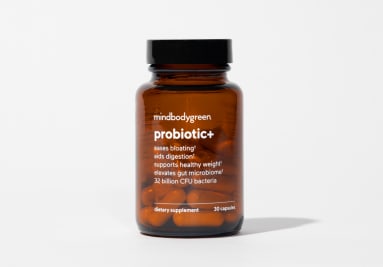Prebiotic Vs. Probiotic: Why You Need Both For A Healthy Gut*


These days it seems like there's a lot of hype about the gut microbiome and gut health. If the science around these popular topics feels confusing or overwhelming to you, don't worry, you're definitely not alone. For example, there are prebiotics and probiotics—but do you really need both for optimal gut health?*
What's a probiotic?
Probiotics are beneficial bacteria that can improve the microbial balance and help to support gut health.*
In other words, these are live organisms that, when administered in adequate amounts (like in a supplement capsule filled with tens of billions of live bacteria) can bring health benefits to the host (us).*
One of the most common, straightforward ways to incorporate more of these good bugs is through a high-quality probiotic supplement.
You can also add more probiotic foods to your diet.
Here is a list of my favorite probiotic foods, they are easy to find and full of beneficial bacteria:
- Miso
- Tempeh
- Kvass
- Sauerkraut
- Apple cider vinegar
- Natto
- Kimchi
- Kefir
- Pickles (make sure they are really fermented pickles)
- Kombucha
I often remember to tell patients that just because you take a probiotic doesn't give you an excuse to eat fast and packaged or processed foods. The right ingredients (prebiotics) must be present in your diet in order for the probiotics (good microbes) to be able to flourish and thrive.*
Some popular types of probiotics include organisms like Lactobacillus acidophilus1, Bifidobacterium lactis, Lactobacillus rhamnosus, Lactobacillus reuteri, Lactobacillus casei, Lactobacillus acidophilus, Bacillus coagulans, Escherichia coli strain Nissle 1917, Enterococcus faecium SF68, and the yeast Saccharomyces boulardi.
(Clearly there are a lot of options: If you need some help, here's how to choose the right probiotic.)
Summary
What's a prebiotic?
Prebiotics are largely nondigestible fibers that provide nourishment for beneficial bacteria.*
Think of prebiotics as fertilizer for the good guys. Some examples of prebiotics include FOS, inulin, and flaxseed fiber.
FOS refers to fructooligosaccharides2; these are low-calorie, nondigestible carbohydrates, and they occur naturally in certain plants like onion, chicory, garlic, asparagus, banana, artichoke, and many others.
One of the most famous prebiotics comes from human milk oligosaccharides3, a key component of human breast milk, as it has been shown to promote the growth of beneficial bacteria in our gut microbiome such as Bifidobacterium.
Here is a list of some prebiotic foods that are easy to incorporate into your diet to help feed your beneficial good bugs:
- Flaxseed
- Raw asparagus
- Raw jicama
- Green bananas
- Raw Jerusalem artichoke (sunroot)
- Raw dandelion greens
- Raw garlic
- Raw/cooked onion
- Raw leek
- Raw chicory root
- Acacia gum (gum Arabic)
Summary
Do you need probiotics and prebiotics?
In short, yes. The word "synbiotic" refers to the combination of probiotics and prebiotics and how they work together, in synergy, to improve health.*
Some research suggests that when prebiotics are added to the probiotics4, there is improved viability5 of the probiotic.*
This basically means that if you combine probiotics with prebiotic "food," for those probiotics, it might possibly be more likely to survive and plant its flag in your gut.
In other words, you should always be eating prebiotic fiber-rich foods along with your probiotics.
So, if you are looking for a way to help give your gut microbiome a boost, you might want to consider a combination of probiotics and prebiotics.*
If you eat a well-balanced diet that is rich in prebiotic foods, probiotic foods, and other gut-centric, microbiome-balancing herbs, spices, teas, and foods, you will be well on your way to being one step ahead of the game.
This synbiotic style of eating will help keep your gut microbiome diversity and richness scales more ideal. Your whole body will benefit.
Summary

Marvin Singh, M.D is an Integrative Gastroenterologist in San Diego, California, and a Member of the Board and Diplomate of the American Board of Integrative Medicine. He is also trained and board certified in Internal Medicine and Gastroenterology/Hepatology. A graduate of Virginia Commonwealth University School of Medicine, Singh completed his residency training in Internal Medicine at the University of Michigan Health System followed by fellowship training in Gastroenterology at Scripps Clinic Torrey Pines. Singh was trained by Andrew Weil, M.D., a pioneer in the field of integrative medicine, at the Andrew Weil Center for Integrative Medicine.
Singh is currently the Director of Integrative Gastroenterology at the Susan Samueli Integrative Health Institute at UC Irvine. He is also currently a voluntary Assistant Clinical Professor at UCSD in the Department of Family Medicine and Public Health; prior to this, he has been a Clinical Assistant Professor at UCLA and an Assistant Professor of Medicine at Johns Hopkins University. Singh is a member of the American Academy of Anti-Aging Medicine, American College of Lifestyle Medicine, and many other societies. He is actively involved in the American Gastroenterological Association. He is one of the editors of the textbook of Integrative Gastroenterology, 2nd edition (a Weil Series text) and has written several book chapters and articles.
He is dedicated to guiding his clients toward optimal wellness every step of the way, using the most cutting edge technologies to design highly personalized precision based protocols. Towards this end, he founded Precisione Clinic and wrote the book Rescue Your Health to bring the best in preventive medicine to his clients.

